Start Licensing’s Ian Downes switches supermarkets this week and finds further evidence of licensing playing a part in a range of product categories.
Like most of us, I have felt that I am living a Groundhog Day life at the moment. My routine has become routine. My shopping and Looking Out has generally been centred around the shopping trips I have made for my mum. I broke out of the routine this week by visiting my local Tesco store. It was very uplifting to see some different supermarket shelves. A real sign of the times that a visit to a supermarket could be a feel good moment!
My trip to Tesco provided me ample evidence that licensing is playing a part in a range of product categories and that there has still been a lot of NPD work being undertaken despite the challenges we have all faced.
It is the ‘international break’ in men’s professional football at the moment as players are involved in qualifying matches for the European Football Championships. The tournament was originally scheduled to take place in 2020. It has been rescheduled for this year, but still retains the EURO 2020 branding. There have been a lot of qualifying matches this week and it has been good to see a tournament like the Euros is up and running. Sporting events like this have been a welcome distraction for sports fans.
Against this backdrop it was reassuring and encouraging to see the commitment that Panini has shown to its ‘official EURO 2020’ sticker collection. It had secured a lot of space within the magazine department at Tesco including the use of a FSDU. It must have been very difficult for licensees working on tournaments like EURO 2020 to manage inventory and retail relationships. It must also have been hard to switch marketing campaigns on and off. It is reassuring to see an experienced licensee like Panini staying in the game and supporting their product in such a robust way.
It is also comforting to see a traditional product format like a sticker collection still appearing to thrive. Companies like Panini have enhanced collections with additions such as digital content, but essentially the appeal of the product remains as it always was. Success relies on securing strong licences coupled with good distribution and proactive promotion. No one visiting the Tesco store I shopped in would have struggled to see and find the Panini collection.
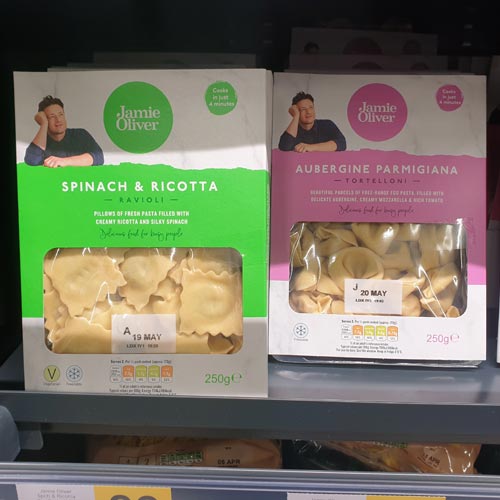
Jamie Oliver also seems to have kept busy during lockdown. Jamie Oliver is a well established brand name in the FMCG category. Tesco is selling a range of Jamie Oliver fresh pastas, gnocchi and sauces in the chiller cabinet. I understand these have launched exclusively in Tesco. It seems a natural product category for Jamie Oliver to develop as Italian food has been a big part of his culinary life. Of course, there were a number of Jamie’s Italian restaurants as well.
The product in Tesco is well presented with a very contemporary packing style that uses colour very well featuring an image of Jamie and his signature brand roundel. The range works well as a convenient pick up meal item – the pasta and gnocchi are sold side by side with the sauces. Jamie has helped curate your meal time. The product is produced under licence by a company called Chef Brand. Looking at its website, it seems it has targeted a specific product category and type of product. The Jamie Oliver endorsement gives it an identity and a strong point of difference. It has undoubtedly helped the company secure retail distribution as well.
It is interesting that this range seems to have launched exclusively in Tesco. There is always a trade off with working exclusively with a retailer, but of course it helps when securing a platform to launch a product from. I suspect more retailers will be looking to run exclusive product ranges like this in the hope that they persuade consumers to shop with them and help the retailer create a point of difference.
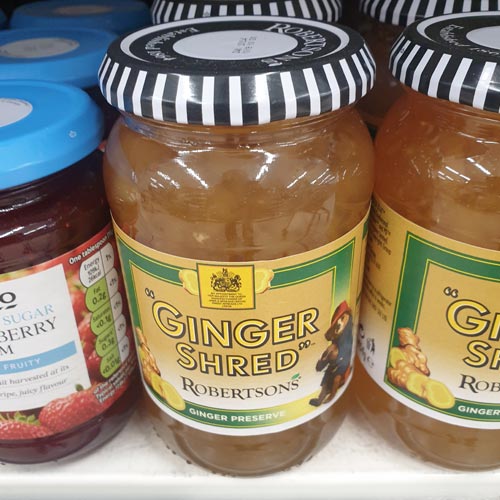
It is also encouraging to see classic characters continuing to thrive in the FMCG sector. A good example of this is Robertsons’ use of Paddington. I spotted the little bear on a jar of Ginger Shred marmalade. A nice line editorially and from a product development point of view, but also a good example of how a well matched character and product can survive in the ultra competitive world of FMCG.
It is important to remember licensed brands are competing head to head with some very powerful FMCG brands. It can be hard to compete even for the strongest licensed brands.
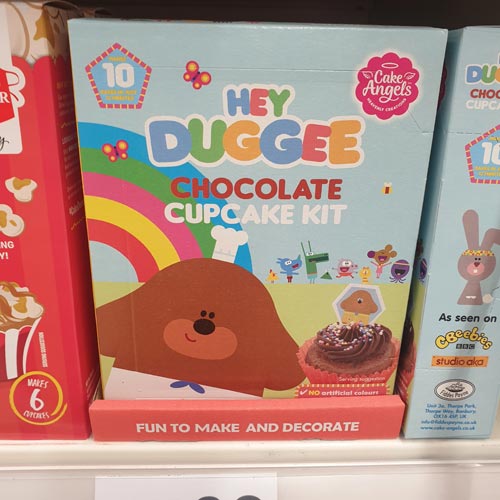
Another category that relies heavily on licensing is that of cake mix kits. This is a category that uses licenses in a long-term way. The dynamics of the category mean that they can’t chop and change that often.
Companies like Fiddes Payne take a considered view on which licences to run with and are choosing them carefully, with the hope that they will stay in range for some time. It is difficult to get into the category from a licensing point of view, but once on shelf it can be a very rewarding category to feature in.
I noticed that Hey Duggee features in the category now. This is a kind of benchmark of the maturity of a character and this would suggest Hey Duggee is an increasingly well established character.
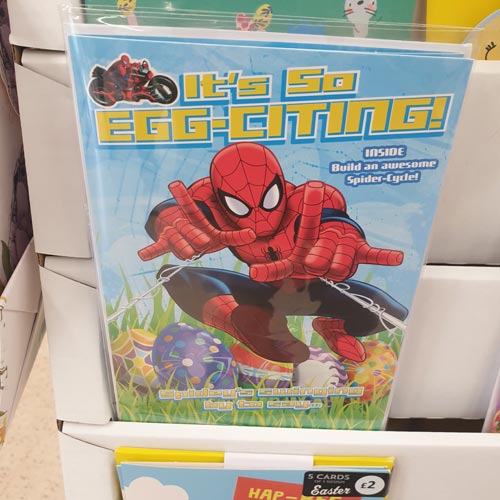
One feature of licensing that has changed in recent times is the industry’s ability to recognise and, in some cases create, new uses for licensing and licensed characters. On this visit I saw two good examples of this. The first being Spider-Man featuring on an Easter card from Hallmark – part of a FSDU of Easter cards that featured a few licensed cards. The strapline ‘It’s so Egg-Citing’ leaves you in no doubt that it is an Easter card!
Another example of licensing featuring in a diverse category is a Peppa Pig branded gift card. Peppa Pig featured in a range of Tesco Gift Cards that were being sold on clip strips at an aisle end. This was also a good example of how retailers seem to be using clip strips more and more around their stores. I guess this encourages product pick up, creates more space and allows them to introduce new products.
I mentioned how hard it is for licensed brands to compete with well established FMCG brands in supermarkets. Big brands have big budgets to spend on promotions, advertising and in-store activation. They protect their shelf space well. But they are not adverse to using licensing themselves to create new products and drive fresh interest in their brands.
Unilever is a great example of a company that embraces licensing well and a company that uses licensing to stretch its brands, seeking out new ‘brand occasions’. Marmite is a great example of this. I guess the Marmite licensing programme has given it a lot of insights and connections that it can use on other brands in the portfolio.
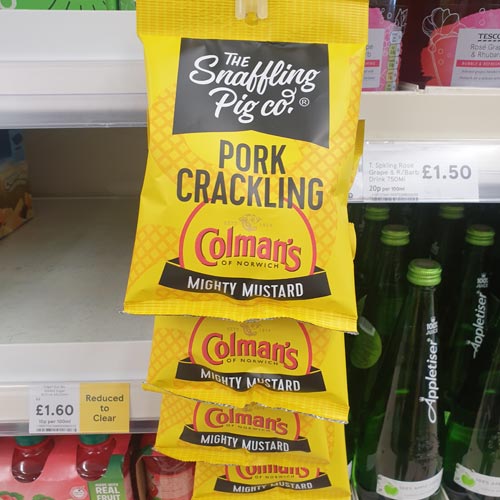
I noticed that the Unilever brand Colman’s Mustard has linked with The Snaffling Pig Co. to develop Colman’s Mighty Mustard Pork Crackling. The product is being sold on a clip strip in the snacking aisle and stands out really well, not least as it uses the signature Colman’s yellow. I suspect one of the drivers for this deal for Unilever is that it gives it an opportunity to reach younger consumers, get Colman’s into the ‘on the go’ food market and to back up other brand messages it is working on.
It is not a product I will try – I love Colman’s Mustard but don’t eat meat – hopefully there will be some veggie options soon! It seems like a great partnership for The Snaffling Pig Co, linking its product with a well established brand that is a category leader.
I am looking forward to changing up my routine a bit more over the next few weeks, not least by taking part in The Light Fund fundraiser in memory of Kelvyn Gardner. It is a lovely way to remember Kelvyn and to get active. The industry is aiming to complete 10,000km in Kelvyn’s memory. Every K counts!
You can get kitted out by clicking on this link.
Look out for fellow walkers, runners and cyclists wearing the Kelvyn kit. You never know you might meet a new licensing friend in your local area.
Ian Downes runs Start Licensing, an independent brand licensing agency. His Twitter handle is @startlicensing – he would welcome your suggestions for what to look out for.































